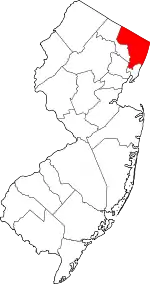Ho-Ho-Kus, New Jersey
Ho-Ho-Kus /hoʊˈhoʊkəs/ is a borough in Bergen County, New Jersey, United States. As of the 2010 census, the borough's population was 4,078,[8][9][10] reflecting an increase of 18 (+0.4%) from the 4,060 counted in the 2000 Census, which had in turn increased by 125 (+3.2%) from the 3,935 counted in the 1990 Census.[20] The borough is the home of several historical landmarks, including the Ho-Ho-Kus Inn and The Hermitage.
Ho-Ho-Kus, New Jersey | |
|---|---|
| Borough of Ho-Ho-Kus | |
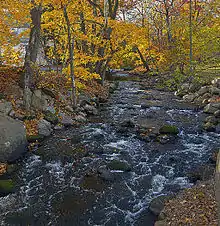 The Ho-Ho-Kus Brook flowing through downtown Ho-Ho-Kus | |
 Map highlighting Ho-Ho-Kus's location within Bergen County. Inset: Bergen County's location within New Jersey | |
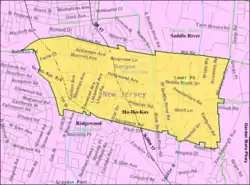 Census Bureau map of Ho-Ho-Kus, New Jersey | |
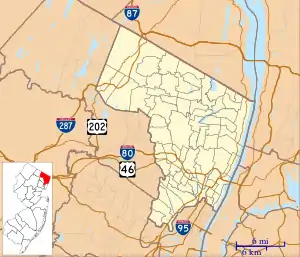 Ho-Ho-Kus Location in Bergen County 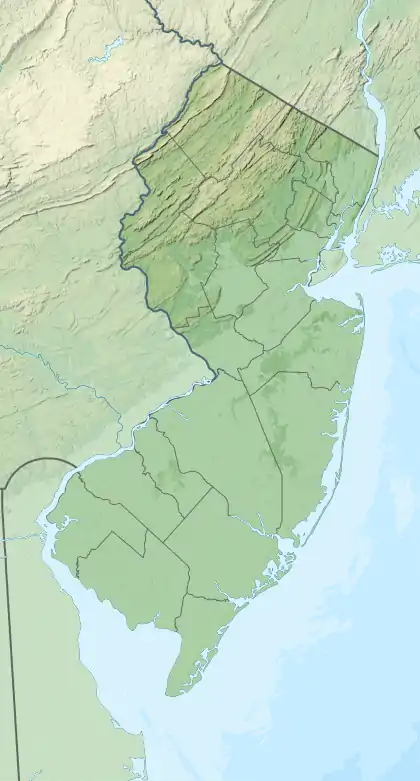 Ho-Ho-Kus Location in New Jersey  Ho-Ho-Kus Location in the United States | |
| Coordinates: 40.9995°N 74.096583°W[1][2] | |
| Country | |
| State | |
| County | |
| Incorporated | March 8, 1905 (as Orvil) |
| Reincorporated | October 12, 1908 (as Ho-Ho-Kus) |
| Government | |
| • Type | Borough |
| • Body | Borough Council |
| • Mayor | Thomas W. Randall (R, term ends December 31, 2023)[4][5] |
| • Administrator | William J. Jones[4] |
| • Municipal clerk | Joan Herve[6] |
| Area | |
| • Total | 1.75 sq mi (4.53 km2) |
| • Land | 1.74 sq mi (4.51 km2) |
| • Water | 0.01 sq mi (0.03 km2) 0.63% |
| Area rank | 425th of 565 in state 53rd of 70 in county[1] |
| Elevation | 121 ft (37 m) |
| Population | |
| • Total | 4,078 |
| • Estimate (2019)[11] | 4,065 |
| • Rank | 409th of 566 in state 63rd of 70 in county[12] |
| • Density | 2,350.3/sq mi (907.5/km2) |
| • Density rank | 259th of 566 in state 54th of 70 in county[12] |
| Demonym(s) | Ho-Ho-Kusite[13] |
| Time zone | UTC−05:00 (Eastern (EST)) |
| • Summer (DST) | UTC−04:00 (Eastern (EDT)) |
| ZIP Code | |
| Area code(s) | 201[16] |
| FIPS code | 3400332310[1][17][18] |
| GNIS feature ID | 0885258[1][19] |
| Website | www |
Ho-Ho-Kus was incorporated as a borough by an act of the New Jersey Legislature on October 12, 1908, from what had originally been the borough of Orvil, which was in turn created on March 8, 1905, from portions of Orvil Township.[21][22]
As of the 2000 United States Census, Ho-Ho-Kus was the 15th-wealthiest community in New Jersey with a per capita money income of $63,594 as of 1999, an increase of 36.9% from the $46,451 recorded in 1989.[23] The borough's median household income was $165,827 in 2013.[24] In 2011, New Jersey Monthly magazine named Ho-Ho-Kus the best place to live in the state of New Jersey, citing its affluence, low crime rate and the quality of its school system, as well as its proximity to New York City and other major commercial destinations.[25]
A person from Ho-Ho-Kus is known as a "Ho-Ho-Kusite".[13]
History of the name
The meaning of the name Ho-Ho-Kus is in debate. From the official history on the borough's website, the most likely origin is a contraction of the Delaware Indian term "Mah-Ho-Ho-Kus" (or "Mehokhokus"), meaning "the red cedar."[26][27]
Other meanings have been suggested over the years and are listed on the borough's website, including an Indian word for running water, a cleft in the rock or under the rock or hollow rock, the word "hohokes", signifying the whistle of the wind against the bark of trees, the Chihohokies Indians whose chief lived here, the Dutch Hoog Akers for "high acorns" or Hoge Aukers, Dutch for "high oaks", the Indian word hoccus meaning "fox", or woakus, "gray fox", or that the "Ho" part means joy or spirit, and the rest of the name from "hohokes," meaning a kind of bark of a tree.[28][29]
Ho-Ho-Kus versus Hohokus
A constant source of confusion has been the manner in which the borough's name has been styled, with each syllable capitalized and separated by hyphens. The confusion is only exacerbated by the existence of Hohokus Township, which comprised the area of present-day Ho-Ho-Kus and other surrounding communities, yet was styled without the multiple capitalization or the hyphens. Ho-Ho-Kus is served by interchange 168 on the Garden State Parkway which lists the municipality as "Hohokus" on its exit signing.[30]
The name "Ho-Ho-Kus" was used explicitly in the resolution requesting a change of name passed by the Borough Council on October 12, 1908 and submitted to the Secretary of State of New Jersey requesting "That the Borough now known as the Borough of Orvil be hereafter known as the Borough of Ho-Ho-Kus..."
A few theories have been offered for the hyphens and capitalization. One is that it was intended to differentiate between the borough and Hohokus Township, which was formed on April 9, 1849, and continued to exist until November 7, 1944, when a referendum was passed changing the name to present-day Mahwah.[21][13] Another explanation was that it was meant to avoid confusion by postal clerks with mail being sent to Hoboken.
While efforts had been made in the ensuing decades to change the name or to alter the way in which the name of the borough is capitalized and punctuated, the borough remains as "Ho-Ho-Kus."[31]
Geography

According to the United States Census Bureau, the borough had a total area of 1.75 square miles (4.53 km2), including 1.74 square miles (4.51 km2) of land and 0.01 square miles (0.03 km2) of water (0.63%).[1][2]
The borough borders Hillsdale, Ridgewood, Saddle River, Waldwick and Washington Township.[32][33][34]
Demographics
| Historical population | |||
|---|---|---|---|
| Census | Pop. | %± | |
| 1900 | 316 | — | |
| 1910 | 488 | 54.4% | |
| 1920 | 586 | 20.1% | |
| 1930 | 925 | 57.8% | |
| 1940 | 1,626 | 75.8% | |
| 1950 | 2,254 | 38.6% | |
| 1960 | 3,988 | 76.9% | |
| 1970 | 4,348 | 9.0% | |
| 1980 | 4,129 | −5.0% | |
| 1990 | 3,935 | −4.7% | |
| 2000 | 4,060 | 3.2% | |
| 2010 | 4,078 | 0.4% | |
| 2019 (est.) | 4,065 | [11][35] | −0.3% |
| Population sources: 1910-1920[36] 1910[37] 1910-1930[38] 1900-2010[39][40][41] 2000[42][43] 2010[8][9][10] | |||
Census 2010
The 2010 United States Census counted 4,078 people, 1,401 households, and 1,154 families in the borough. The population density was 2,350.3 per square mile (907.5/km2). There were 1,462 housing units at an average density of 842.6 per square mile (325.3/km2). The racial makeup was 92.03% (3,753) White, 0.22% (9) Black or African American, 0.07% (3) Native American, 5.79% (236) Asian, 0.00% (0) Pacific Islander, 0.39% (16) from other races, and 1.50% (61) from two or more races. Hispanic or Latino of any race were 4.12% (168) of the population.[8]
Of the 1,401 households, 40.7% had children under the age of 18; 74.2% were married couples living together; 6.6% had a female householder with no husband present and 17.6% were non-families. Of all households, 15.5% were made up of individuals and 9.2% had someone living alone who was 65 years of age or older. The average household size was 2.91 and the average family size was 3.26.[8]
29.3% of the population were under the age of 18, 4.6% from 18 to 24, 18.8% from 25 to 44, 31.5% from 45 to 64, and 16.0% who were 65 years of age or older. The median age was 43.3 years. For every 100 females, the population had 95.5 males. For every 100 females ages 18 and older there were 89.7 males.[8]
The Census Bureau's 2006–2010 American Community Survey showed that (in 2010 inflation-adjusted dollars) median household income was $155,030 (with a margin of error of +/− $14,301) and the median family income was $157,202 (+/− $13,820). Males had a median income of $93,750 (+/− $26,877) versus $83,636 (+/− $27,361) for females. The per capita income for the borough was $67,238 (+/− $11,693). About 1.9% of families and 1.6% of the population were below the poverty line, including 0.6% of those under age 18 and 6.3% of those age 65 or over.[44]
Same-sex couples headed 8 households in 2010, unchanged from 2000.[45]
Census 2000
As of the 2000 United States Census[17] there were 4,060 people, 1,433 households, and 1,199 families residing in the borough. The population density was 2,331.1 people per square mile (900.9/km2). There were 1,465 housing units at an average density of 841.2 per square mile (325.1/km2). The racial makeup of the borough was 92.66% White, 0.59% African American, 0.10% Native American, 5.22% Asian, 0.20% Pacific Islander, 0.37% from other races, and 0.86% from two or more races. 1.97% of the population were Hispanic or Latino of any race.[42][43]
There were 1,433 households, out of which 38.7% had children under the age of 18 living with them, 76.6% were married couples living together, 6.1% had a female householder with no husband present, and 16.3% were non-families. Of all households 14.6% were made up of individuals, and 7.1% had someone living alone who was 65 years of age or older. The average household size was 2.82 and the average family size was 3.11.[42][43]
In the borough the population was spread out, with 27.5% under the age of 18, 3.3% from 18 to 24, 26.6% from 25 to 44, 27.3% from 45 to 64, and 15.2% who were 65 years of age or older. The median age was 41 years. For every 100 females, there were 91.9 males. For every 100 females age 18 and over, there were 88.2 males.[42][43]
The median income for a household in the borough was $129,900, and the median income for a family was $144,588. Males had a median income of $92,573 versus $54,091 for females. The per capita income for the borough was $63,594. Of the population 2.1% of the people and 2.6% of families were below the poverty line. Of those 0.7% under the age of 18 and 1.6% of those 65 and older were living below the poverty line.[42][43]
Affluence
Ho-Ho-Kus is primarily an upper-class and upper-middle class suburb of New York City, ranking 15th in the state of New Jersey in terms of per-capita income. According to the Forbes 2010 survey of the most expensive ZIP codes in America, Ho-Ho-Kus ranked 268th nationally, with a median home price of $901,841.[46]
The Ho-Ho-Kus School District is classified in District Factor Group "J," the highest of eight categories, in both the 2000 and 1990 rankings. District Factor Groups are used in the state of New Jersey to rank school districts according to common socioeconomic characteristics. Northern Highlands Regional High School, which receives students from Ho-Ho-Kus, Allendale, Upper Saddle River, and part of Saddle River, is placed in the same category.[47]
Points of interest
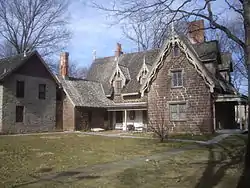
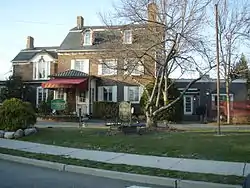
- The Hermitage, site of Aaron Burr's marriage, listed on the National Register of Historic Places[48]
- The Ho-Ho-Kus Inn (also known as Ho-Ho-Kus Inn & Tavern), is a historic landmark that is currently a restaurant.[49]
Government
Local government
Ho-Ho-Kus is governed under the Borough form of New Jersey municipal government, which is used in 218 municipalities (of the 565) statewide, making it the most common form of government in New Jersey.[50] The governing body is comprised of a Mayor and a Borough Council, with all positions elected at-large on a partisan basis as part of the November general election. A Mayor is elected directly by the voters to a four-year term of office. The Borough Council is comprised of six members elected to serve three-year terms on a staggered basis, with two seats coming up for election each year in a three-year cycle.[3] The Borough form of government used by Ho-Ho-Kus is a "weak mayor / strong council" government in which council members act as the legislative body with the mayor presiding at meetings and voting only in the event of a tie. The mayor can veto ordinances subject to an override by a two-thirds majority vote of the council. The mayor makes committee and liaison assignments for council members, and most appointments are made by the mayor with the advice and consent of the council.[51][52]
As of 2020, the Mayor of Ho-Ho-Kus is Republican Thomas W. Randall, whose term of office ends December 31, 2023. Members of the Borough Council are Council President Douglas K. Troast (R, 2021), Kevin Crossley (R, 2022), Edmund M. Iannelli (R, 2020), Kathleen Moran (R, 2022; appointed to serve an unexpired term), Dane M. Policastro (R, 2021) and Steven D. Shell (R, 2020).[4][53][54][55][56][57]
In February 2020, Kathleen Moran was selected from three candidates nominated by the Republican municipal committee to fill the seat expiring in December 2022 that had been held by Philip Rorty until he resigned from office earlier that month.[58]
Thomas Fiato was selected in January 2016 from a list of three candidates nominated by the municipal Republican committee to fill the seat of Kimberley Weiss, who had resigned earlier that month after announcing that she was relocating out of the borough.[59]
William J. Jones is the Borough Administrator.[4]
Federal, state and county representation
Ho-Ho-Kus is located in New Jersey's 5th congressional district[60] and is part of the 40th state legislative district.[9][61][62] Prior to the 2011 reapportionment following the 2010 Census, Ho-Ho-Kus had been in the 39th state legislative district.[63]
For the 116th United States Congress, New Jersey's Fifth Congressional District is represented by Josh Gottheimer (D, Wyckoff).[64][65] New Jersey is represented in the United States Senate by Democrats Cory Booker (Newark, term ends 2021)[66] and Bob Menendez (Paramus, term ends 2025).[67][68]
For the 2020–2021 session (Senate, General Assembly), the 40th Legislative District of the New Jersey Legislature is represented in the State Senate by Kristin Corrado (R, Totowa) and in the General Assembly by Christopher DePhillips (R, Wyckoff) and Kevin J. Rooney (R, Wyckoff).[69][70]
Bergen County is governed by a directly elected County Executive, with legislative functions performed by a seven-member Board of Chosen Freeholders. The freeholders are elected at-large in partisan elections on a staggered basis, with two or three seats coming up for election each year; a Chairman, Vice Chairman and Chairman Pro Tempore are selected from among its seven members at a reorganization meeting held each January.[71][72] As of 2018, the County Executive is Democratic James J. Tedesco III of Paramus, whose term of office ends December 31, 2018.[73] Bergen County's Freeholders are Freeholder Chairman Thomas J. Sullivan Jr., (D, Montvale, term as freeholder ends 2019; term as freeholder chairman ends 2018),[74] Freeholder Vice-Chairwoman Germaine M. Ortiz (D, Emerson, term as freeholder ends 2019; term as freeholder vice-chairwoman ends 2018),[75] Freeholder Chairman Pro-Tempore Mary J. Amoroso (D, Mahwah, term as freeholder ends 2019; term as freeholder chairman pro-tempore ends 2018),[76] David L. Ganz (D, Fair Lawn, 2020),[77] Steve Tanelli (D, North Arlington, 2018),[78] Joan Voss (D, Fort Lee, 2020)[79] and Tracy Silna Zur (D, Franklin Lakes, 2018),[80][81][82][71] Bergen County's constitutional officials are County Clerk John S. Hogan (D, Northvale, 2021),[83][84] Sheriff Michael Saudino (D, Emerson, 2019)[85][86] and Surrogate Michael R. Dressler (D, Cresskill, 2021).[87][88][71][89]
Politics
As of March 23, 2011, there was a total of 2,981 registered voters in Ho-Ho-Kus, of whom 546 (18.3% vs. 31.7% countywide) were registered as Democrats, 1,456 (48.8% vs. 21.1%) were registered as Republicans and 976 (32.7% vs. 47.1%) were registered as Unaffiliated. There were 3 voters registered to other parties.[90] Among the borough's 2010 Census population, 73.1% (vs. 57.1% in Bergen County) were registered to vote, including 103.3% of those ages 18 and over (vs. 73.7% countywide).[90][91]
In the 2016 presidential election, Republican Donald Trump received 1,171 votes (48.1% vs. 41.1% countywide), ahead of Democrat Hillary Clinton with 1,131 votes (46.5% vs. 54.2%) and other candidates with 131 votes (5.4% vs. 4.6%), among the 2,462 ballots cast by the borough's 3,234 registered voters, for a turnout of 76.1% (vs. 72.5% in Bergen County).[92] In the 2012 presidential election, Republican Mitt Romney received 1,447 votes (62.8% vs. 43.5% countywide), ahead of Democrat Barack Obama with 826 votes (35.9% vs. 54.8%) and other candidates with 21 votes (0.9% vs. 0.9%), among the 2,303 ballots cast by the borough's 3,116 registered voters, for a turnout of 73.9% (vs. 70.4% in Bergen County).[93][94] In the 2008 presidential election, Republican John McCain received 1,440 votes (58.1% vs. 44.5% countywide), ahead of Democrat Barack Obama with 1,009 votes (40.7% vs. 53.9%) and other candidates with 15 votes (0.6% vs. 0.8%), among the 2,478 ballots cast by the borough's 3,066 registered voters, for a turnout of 80.8% (vs. 76.8% in Bergen County).[95][96] In the 2004 presidential election, Republican George W. Bush received 1,547 votes (62.2% vs. 47.2% countywide), ahead of Democrat John Kerry with 916 votes (36.8% vs. 51.7%) and other candidates with 18 votes (0.7% vs. 0.7%), among the 2,489 ballots cast by the borough's 2,987 registered voters, for a turnout of 83.3% (vs. 76.9% in the whole county).[97]
In the 2013 gubernatorial election, Republican Chris Christie received 74.4% of the vote (1,085 cast), ahead of Democrat Barbara Buono with 24.6% (358 votes), and other candidates with 1.0% (15 votes), among the 1,479 ballots cast by the borough's 3,042 registered voters (21 ballots were spoiled), for a turnout of 48.6%.[98][99] In the 2009 gubernatorial election, Republican Chris Christie received 1,063 votes (62.5% vs. 45.8% countywide), ahead of Democrat Jon Corzine with 553 votes (32.5% vs. 48.0%), Independent Chris Daggett with 76 votes (4.5% vs. 4.7%) and other candidates with 3 votes (0.2% vs. 0.5%), among the 1,701 ballots cast by the borough's 3,024 registered voters, yielding a 56.3% turnout (vs. 50.0% in the county).[100]
Education
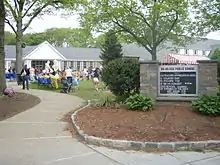
The Ho-Ho-Kus School District serves public school students in pre-kindergarten through eighth grade at Ho-Ho-Kus Public School.[101] As of the 2018–19 school year, the district, comprised of one school, had an enrollment of 599 students and 46.0 classroom teachers (on an FTE basis), for a student–teacher ratio of 13.0:1.[102] The school population increased more than 200 students in the decade through 2008.[103]
Local secondary school students in public school attend Northern Highlands Regional High School in nearby Allendale, which serves students in the ninth through twelfth grades grades from Allendale, Ho-Ho-Kus, Upper Saddle River and some students from Saddle River, as part of sending/receiving relationships with the Ho-Ho-Kus district.[25][104] As of the 2018–19 school year, the high school had an enrollment of 1,377 students and 110.4 classroom teachers (on an FTE basis), for a student–teacher ratio of 12.5:1.[105]
After ending a long-standing sending relationship to Ridgewood High School in the mid-1970s, Ho-Ho-Kus students started attending Midland Park High School. The small size of the Midland Park school and the lack of electives led to efforts in the mid-1990s to find another high school to serve students from the borough.[26] Since then, high school students from Ho-Ho-Kus have been attending Northern Highlands Regional High School.[106] The send / receive agreement between Ho-Ho-Kus and Northern Highlands began in the 1990s.[107] In 2016, the Ho-Ho-Kus and Northern Highlands districts reached an agreement to extend the send / receive agreement through 2026 under a fixed-price contract by which Ho-Ho-Kus would pay $3.6 million for the 2016–17 school year, escalating by 2% a year to $4.3 million in 2025–26, regardless of the number of students from the borough sent to the high school.[108]
Public school students from the borough, and all of Bergen County, are eligible to attend the secondary education programs offered by the Bergen County Technical Schools, which include the Bergen County Academies in Hackensack, and the Bergen Tech campus in Teterboro or Paramus. The district offers programs on a shared-time or full-time basis, with admission based on a selective application process and tuition covered by the student's home school district.[109][110]
The borough is home to the Ho-Ho-Kus Waldwick Cooperative Nursery School.[111]
Transportation
_in_Ho-Ho-Kus%252C_Bergen_County%252C_New_Jersey.jpg.webp)
Roads and highways
As of May 2010, the borough had a total of 26.52 miles (42.68 km) of roadways, of which 19.50 miles (31.38 km) were maintained by the municipality, 6.01 miles (9.67 km) by Bergen County and 1.01 miles (1.63 km) by the New Jersey Department of Transportation.[112]
Route 17, County Route 507, and County Route 502 travel through Ho-Ho-Kus.

Ho-Ho-Kus can also be accessed via exit 168 on the Garden State Parkway.
Public transportation
Ho-Ho-Kus is served by NJ Transit at the Ho-Ho-Kus station, which is located at Brookside Avenue and 1st Street, one block from Franklin Turnpike.[113] The station provides service on both the Bergen County Line and Main Line, which run north–south to Hoboken Terminal with connections via the Secaucus Junction transfer station to NJ Transit New York Penn Station and to other NJ Transit rail service. Connections are available at the Hoboken Terminal to other NJ Transit rail lines, the PATH train at the Hoboken PATH station, New York Waterways ferry service to the World Financial Center and other destinations and Hudson-Bergen Light Rail service.[114][115][116]
Short Line provides service between the borough and the Port Authority Bus Terminal in Midtown Manhattan from a stop at Route 17 and Hollywood Avenue, with limited service offered at a stop at Franklin Turnpike and Maple Avenue.[117]
Notable people
People who were born in, residents of, or otherwise closely associated with Ho-Ho-Kus include:
- Aaron Burr (1756–1836), third Vice President of the United States, was married at The Hermitage and briefly lived there.[118]
- David Duffield (born 1941), businessman and founder of Information Associates, Integral Software Systems, Business Software, PeopleSoft, and Workday.[119]
- Jim Fassel (born 1949), former head coach of the New York Giants.[120]
- Dennis McNerney, former County Executive of Bergen County.[121]
- Dan Reeves (born 1944), former running back of the Dallas Cowboys, former head coach of the New York Giants.[122]
- R. Tom Sawyer (1901–1986), engineer, writer and inventor of the first successful gas turbine locomotive.[123]
- Twisted Sister, heavy metal band best known for the songs "We're Not Gonna Take It" and "I Wanna Rock".[124]
- Metta Victoria Fuller Victor (1831–1885), novelist, credited with authoring of one of the first American detective novels who wrote more than 100 dime novels, pioneering the field.[125]
- Orville James Victor (1827–1910), theologian, journalist, editor and abolitionist who has been called the creator of the dime novel.[126]
- Richard Warch (1939–2013), 14th president of Lawrence University.[127]
Sources
- Municipal Incorporations of the State of New Jersey (according to Counties) prepared by the Division of Local Government, Department of the Treasury (New Jersey); December 1, 1958.
- Clayton, W. Woodford; and Nelson, William. History of Bergen and Passaic Counties, New Jersey, with Biographical Sketches of Many of its Pioneers and Prominent Men. Philadelphia: Everts and Peck, 1882.
- Harvey, Cornelius Burnham (ed.), Genealogical History of Hudson and Bergen Counties, New Jersey. New York: New Jersey Genealogical Publishing Co., 1900.
- Hudson, Sue F., Background of Ho-Ho-Kus History, under the auspices of the Woman's Club of Ho-Ho-Kus, New Jersey, 1953
- Van Valen, James M. History of Bergen County, New Jersey. New York: New Jersey Publishing and Engraving Co., 1900.
- Westervelt, Frances A. (Frances Augusta), 1858–1942, History of Bergen County, New Jersey, 1630-1923, Lewis Historical Publishing Company, 1923.
References
- 2019 Census Gazetteer Files: New Jersey Places, United States Census Bureau. Accessed July 1, 2020.
- US Gazetteer files: 2010, 2000, and 1990, United States Census Bureau. Accessed September 4, 2014.
- 2012 New Jersey Legislative District Data Book, Rutgers University Edward J. Bloustein School of Planning and Public Policy, March 2013, p. 165.
- Meet Our Mayor and Council, Borough of Ho-Ho-Kus. Accessed March 26, 2022.
- 2020 New Jersey Mayors Directory, New Jersey Department of Community Affairs. Accessed February 1, 2020.
- Borough Clerk, Borough of Ho-Ho-Kus. Accessed March 26, 2020.
- U.S. Geological Survey Geographic Names Information System: Borough of Ho-Ho-Kus, Geographic Names Information System. Accessed March 5, 2013.
- DP-1 - Profile of General Population and Housing Characteristics: 2010 for Ho-Ho-Kus borough, Bergen County, New Jersey Archived February 12, 2020, at Archive.today, United States Census Bureau. Accessed December 15, 2011.
- Municipalities Sorted by 2011-2020 Legislative District, New Jersey Department of State. Accessed February 1, 2020.
- Table DP-1. Profile of General Demographic Characteristics: 2010 for Ho-Ho-Kus borough Archived 2012-04-02 at the Wayback Machine, New Jersey Department of Labor and Workforce Development. Accessed December 15, 2011.
- Annual Estimates of the Resident Population for Minor Civil Divisions in New Jersey: April 1, 2010 to July 1, 2019, United States Census Bureau. Accessed May 21, 2020.
- GCT-PH1 Population, Housing Units, Area, and Density: 2010 - State -- County Subdivision from the 2010 Census Summary File 1 for New Jersey Archived February 12, 2020, at Archive.today, United States Census Bureau. Accessed July 31, 2013.
- "Hohokus Or Ho-Ho-Kus?", The Morning Call, January 1, 1940. Accessed June 29, 2020, via Newspapers.com. "Then Hoppertown became Ho-Ho-Kus, the spelling and capitalization intended to set it apart from the township which remained Hohokus. The councilmen thought the capitalization and spelling gave the borough that touch of individualism of which we Americans are so proud. Residents of Ho-ho-kus still hold to that belief.... Hail to the Ho-Ho-Kusite, all 925 of her united population, who are willing to battle the New Deal Administration, the State Government and the Motion Picture industry, in pursuit of an opinion they hold to be right."
- Look Up a ZIP Code for Ho-Ho-Kus, NJ, United States Postal Service. Accessed September 7, 2011.
- Zip Codes, State of New Jersey. Accessed August 28, 2013.
- Area Code Lookup - NPA NX for Ho Ho Kus, NJ, Area-Codes.com. Accessed August 28, 2013.
- U.S. Census website , United States Census Bureau. Accessed September 4, 2014.
- Geographic codes for New Jersey, Missouri Census Data Center. Accessed September 1, 2019.
- US Board on Geographic Names, United States Geological Survey. Accessed September 4, 2014.
- Table 7. Population for the Counties and Municipalities in New Jersey: 1990, 2000 and 2010, New Jersey Department of Labor and Workforce Development, February 2011. Accessed August 27, 2012.
- Snyder, John P. The Story of New Jersey's Civil Boundaries: 1606-1968, Bureau of Geology and Topography; Trenton, New Jersey; 1969. p. 80. Accessed June 6, 2012.
- Municipal Incorporations of the State of New Jersey p. 7, lists a date of October 15, 1908 for the incorporation of Ho-Ho-Kus.
- Money Income (1989 and 1999) and Poverty (1999) New Jersey, Counties and Municipalities, New Jersey State Data Center, April 2003. Accessed August 27, 2012.
- Income in the past 12 months (in 2013 inflation-adjusted dollars) - Ho-Ho-Kus borough, New Jersey Archived April 20, 2015, at Archive.today, United States Census Bureau. Accessed April 20, 2015.
- "The #1 Town: Ho-Ho-Kus", New Jersey Monthly, August 15, 2011. Accessed September 7, 2011.
- Cheslow, Jerry. "If You're Thinking of Living In/Ho-Ho-Kus; A Borough That Guards Its Traditions", The New York Times, February 5, 1995. Accessed August 22, 2011. "The district serves kindergarten through eighth grades. High school students are sent to nearby Midland Park, an arrangement Mayor Sayers terms 'unsatisfactory' because, he says, Midland Park High School is small and offers few electives. The Ho-Ho-Kus Board of Education is discussing possible alternatives."
- Hutchinson, Viola L. The Origin of New Jersey Place Names, New Jersey Public Library Commission, May 1945. Accessed September 1, 2015.
- ""In-Depth History of Ho-Ho-Kus."". Archived from the original on December 4, 2008. Retrieved February 27, 2009.
- Gannett, Henry. The Origin of Certain Place Names in the United States, p. 156. United States Government Printing Office, 1905. Accessed September 1, 2015.
- Travel Resources: Interchanges, Service Areas & Commuter Lots, New Jersey Turnpike Authority. Accessed September 1, 2015.
- Background of Ho-Ho-Kus History pp. 149-150.
- Areas touching Ho-Ho-Kus, MapIt. Accessed February 24, 2020.
- Bergen County Map of Municipalities, Bergen County, New Jersey. Accessed February 24, 2020.
- New Jersey Municipal Boundaries, New Jersey Department of Transportation. Accessed November 15, 2019.
- Census Estimates for New Jersey April 1, 2010 to July 1, 2019, United States Census Bureau. Accessed May 21, 2020.
- Compendium of censuses 1726-1905: together with the tabulated returns of 1905, New Jersey Department of State, 1906. Accessed July 31, 2013.
- Thirteenth Census of the United States, 1910: Population by Counties and Minor Civil Divisions, 1910, 1900, 1890, United States Census Bureau, p. 335. Accessed June 6, 2012.
- Fifteenth Census of the United States : 1930 - Population Volume I, United States Census Bureau, p. 714. Accessed December 15, 2011.
- Table 6. New Jersey Resident Population by Municipality: 1930 - 1990, New Jersey Department of Labor and Workforce Development. Accessed December 15, 2011.
- Bergen County Data Book 2003 Archived 2013-07-24 at the Wayback Machine, Bergen County, New Jersey. Accessed July 31, 2013. Population for 1900, prior to the borough's incorportation, was extrapolated by county statisticians.
- Historical Population Trends in Bergen County (1900-2010), Bergen County Department of Planning & Economic Development, 2011. Accessed September 26, 2019. Data for years prior to the borough's formation was extrapolated by analysts from Bergen County.
- Census 2000 Profiles of Demographic / Social / Economic / Housing Characteristics for Ho-Ho-Kus borough, New Jersey Archived 2012-05-29 at the Wayback Machine, United States Census Bureau. Accessed March 5, 2013.
- DP-1: Profile of General Demographic Characteristics: 2000 - Census 2000 Summary File 1 (SF 1) 100-Percent Data for Ho-Ho-Kus borough, Bergen County, New Jersey Archived February 12, 2020, at Archive.today, United States Census Bureau. Accessed March 5, 2013.
- DP03: Selected Economic Characteristics from the 2006-2010 American Community Survey 5-Year Estimates for Ho-Ho-Kus borough, Bergen County, New Jersey Archived February 12, 2020, at Archive.today, United States Census Bureau. Accessed June 6, 2012.
- Lipman, Harvy; and Sheingold, Dave. "North Jersey sees 30% growth in same-sex couples", The Record (Bergen County), August 14, 2011, backed up by the Internet Archive as of February 3, 2013. Accessed December 1, 2014.
- Most Expensive ZIP Codes: Ho-Ho-Kus, Forbes. Accessed October 10, 2010.
- District Factor Groups (DFG) for School Districts, New Jersey Department of Education. Accessed December 4, 2014.
- The Prevosts: Late Colonial and Revolutionary War Era Archived 2011-07-28 at the Wayback Machine, accessed March 1, 2007.
- History, Ho-Ho-Kus Inn. Accessed May 15, 2016.
- Inventory of Municipal Forms of Government in New Jersey, Rutgers University Center for Government Studies, July 1, 2011. Accessed November 18, 2019.
- Cerra, Michael F. "Forms of Government: Everything You've Always Wanted to Know, But Were Afraid to Ask" Archived 2014-09-24 at the Wayback Machine, New Jersey State League of Municipalities. Accessed November 30, 2014.
- "Forms of Municipal Government in New Jersey", p. 6. Rutgers University Center for Government Studies. Accessed June 3, 2015.
- 2019 Municipal User Friendly Budget, Borough of Ho-Ho-Kus. Accessed October 2, 2019.
- 2018 County and Municipal Directory, Bergen County, New Jersey. Accessed September 26, 2019.
- Bergen County November 5, 2019 General Election Statement of Vote, Bergen County, New Jersey Clerk, updated December 10, 2019. Accessed January 1, 2020.
- Bergen County November 6, 2018 General Election Statement of Vote, Bergen County, New Jersey Clerk, updated February 11, 2019. Accessed September 26, 2019.
- Bergen County Statement of Vote General Election 2017, Bergen County Clerk. Accessed May 15, 2018.
- Mayor and Council Meeting Minutes for February 25, 2020, Borough of Ho-Ho-Kus. Accessed March 26, 2020. "Whereas, there presently exists a vacancy in the membership of the Governing Body by reason of the retirement of Councilman Philip Rorty, effective February 3, 2020; and Whereas, the Ho-Ho-Kus Republican County Committee has submitted three (3) nominees for the selection of a successor to fill the vacancy; and Whereas, the Governing Body has considered the matter; Now, Therefore, Be It Resolved by the Governing Body of the Borough of Ho-Ho-Kus that it hereby appoints Kathleen Moran as the councilperson to serve until the next general election in November, 2020, at which time the vacancy shall be filled for its unexpired term."
- Janoski, Steve. "New Ho-Ho-Kus councilman sets focus on affordable-housing obligation", The Record, March 2, 2016. Accessed March 28, 2016. "Fiato, 55, was sworn in Jan. 26 after the resignation of five-year Councilwoman Kimberly Weiss. Weiss, who won reelection last November, resigned in early January because she was moving out of the borough, local officials said."
- Plan Components Report, New Jersey Redistricting Commission, December 23, 2011. Accessed February 1, 2020.
- 2019 New Jersey Citizen's Guide to Government, New Jersey League of Women Voters. Accessed October 30, 2019.
- Districts by Number for 2011-2020, New Jersey Legislature. Accessed January 6, 2013.
- 2011 New Jersey Citizen's Guide to Government Archived 2013-06-04 at the Wayback Machine, p. 59, New Jersey League of Women Voters. Accessed May 22, 2015.
- Directory of Representatives: New Jersey, United States House of Representatives. Accessed January 3, 2019.
- Biography, Congressman Josh Gottheimer. Accessed January 3, 2019. "Josh now lives in Wyckoff, New Jersey with Marla, his wife who was a federal prosecutor, and their two young children, Ellie and Ben."
- About Cory Booker, United States Senate. Accessed January 26, 2015. "He now owns a home and lives in Newark's Central Ward community."
- Biography of Bob Menendez, United States Senate, January 26, 2015. "He currently lives in Paramus and has two children, Alicia and Robert."
- Senators of the 116th Congress from New Jersey. United States Senate. Accessed April 17, 2019. "Booker, Cory A. - (D - NJ) Class II; Menendez, Robert - (D - NJ) Class I"
- Legislative Roster 2020-2021 Session, New Jersey Legislature. Accessed December 15, 2020.
- District 40 Legislators, New Jersey Legislature. Accessed December 15, 2020.
- 2018 County and Municipal Directory, Bergen County, New Jersey. Accessed June 5, 2018.
- Freeholders, Bergen County, New Jersey. Accessed October 26, 2017.
- County Executive, Bergen County, New Jersey. Accessed February 24, 2018.
- Chairman Thomas J. Sullivan, Bergen County, New Jersey. Accessed February 24, 2018.
- Vice Chairwoman Germaine M. Ortiz, Bergen County, New Jersey. Accessed February 24, 2018.
- Freeholder Mary J. Amoroso , Bergen County, New Jersey. Accessed February 24, 2018.
- Freeholder David L. Ganz, Bergen County, New Jersey. Accessed February 24, 2018.
- Freeholder Steven A. Tanelli, Bergen County, New Jersey. Accessed February 24, 2018.
- Freeholder Dr. Joan M. Voss , Bergen County, New Jersey. Accessed February 24, 2018.
- Tracy Silna Zur, Bergen County, New Jersey. Accessed February 24, 2018.
- Freeholder Board, Bergen County, New Jersey. Accessed February 24, 2018.
- 2017 County Data Sheet, Bergen County, New Jersey. Accessed February 24, 2018.
- About the Clerk, Bergen County Clerk. Accessed February 24, 2018.
- Members List: Clerks, Constitutional Officers Association of New Jersey. Accessed February 24, 2018.
- About Sheriff Michael Saudino, Bergen County Sheriff's Office. Accessed February 24, 2018.
- Members List: Sheriffs, Constitutional Officers Association of New Jersey. Accessed February 24, 2018.
- Michael R. Dressler, Bergen County Surrogate's Court. Accessed February 24, 2018.
- Members List: Surrogates, Constitutional Officers Association of New Jersey. Accessed February 24, 2018.
- Constitutional Officers, Bergen County, New Jersey. Accessed February 24, 2018.
- Voter Registration Summary - Bergen, New Jersey Department of State Division of Elections, March 23, 2011. Accessed December 9, 2013.
- GCT-P7: Selected Age Groups: 2010 - State -- County Subdivision; 2010 Census Summary File 1 for New Jersey Archived February 12, 2020, at Archive.today, United States Census Bureau. Accessed December 9, 2013.
- Presidential November 8, 2016 General Election Results - Bergen County, New Jersey Department of State Division of Elections, November 8, 2016. Accessed May 24, 2020.
- Presidential November 6, 2012 General Election Results - Bergen County Archived September 26, 2018, at the Wayback Machine, New Jersey Department of State Division of Elections, March 15, 2013. Accessed December 13, 2013.
- Number of Registered Voters and Ballots Cast November 6, 2012 General Election Results - Bergen County Archived September 26, 2018, at the Wayback Machine, New Jersey Department of State Division of Elections, March 15, 2013. Accessed December 13, 2013.
- 2008 Presidential General Election Results: Bergen County, New Jersey Department of State Division of Elections, December 23, 2008. Accessed December 9, 2013.
- 2008 General Election Results for Ho-Ho-Kus, The Record. Accessed September 7, 2011.
- 2004 Presidential Election: Bergen County, New Jersey Department of State Division of Elections, December 13, 2004. Accessed December 9, 2013.
- "Governor - Bergen County" (PDF). New Jersey Department of Elections. January 29, 2014. Retrieved December 24, 2014.
- "Number of Registered Voters and Ballots Cast - November 5, 2013 - General Election Results - Bergen County" (PDF). New Jersey Department of Elections. January 29, 2014. Retrieved December 24, 2014.
- 2009 Governor: Bergen County Archived 2018-11-28 at the Wayback Machine, New Jersey Department of State Division of Elections, December 31, 2009. Accessed December 9, 2013.
- Ho-Ho-Kus Board of Education District Policy 0110 - Identification, Ho-Ho-Kus School District. Accessed March 26, 2020. "Purpose: The Board of Education exists for the purpose of providing a thorough and efficient system of free public education in grades Pre-Kindergarten through 12 in the Ho-Ho-Kus School district. Composition The Ho-Ho-Kus School District is comprised of all the area within the municipal boundaries of the Borough of Ho-Ho-Kus."
- District information for Ho-Ho-Kus School District, National Center for Education Statistics. Accessed April 1, 2020.
- Ho-Ho-Kus School, School Digger. Accessed September 21, 2008.
- Northern Highlands Regional High School 2015 Report Card Narrative, New Jersey Department of Education. Accessed May 31, 2016. "A four-year public high school, Northern Highlands strives to address the needs of all of its students who come from four towns in northern Bergen County: Allendale, Upper Saddle River, Ho-Ho-Kus, and Saddle River."
- School data for Northern Highlands Regional High School, National Center for Education Statistics. Accessed April 1, 2020.
- Peterson, Iver. "Taxes May Fuse School Districts; Rising Expenses Test New Jerseyans' Love of Local Control", The New York Times, April 29, 1994. Accessed August 22, 2011. "The proposed district would send Ho-Ho-Kus ninth graders to Northern Highlands Regional High School in Allendale. Northern Highlands High is nationally known for quality, but it is operating at just over half capacity and desperately seeking ties to other districts. Now, Ho-Ho-Kus children go to Midland Park High School after eighth grade."
- Crusco, Jennifer. "Trustees approve new 10-year contract with Highlands", The Villadom Times, March 4, 2009. Accessed September 7, 2011. "The Ho-Ho-Kus Board of Education last week signed a new send/receive contract with Northern Highlands Regional High School in Annandale, which covers 2008 (retroactively) through 2018.... Ho-Ho-Kus has been sending its high school age students to Northern Highlands since the 1990s, when the district severed its send/receive relationship with Midland Park High School."
- Northern Highlands Regional High School and the Borough of Ho-Ho-Kus announced a new 10-year send/receive agreement through 2026 last week.... The total tuition to be paid by Ho-Ho-Kus for the 2016 to 2017 school year is $3,580,675. The fee increases by approximately 2 percent per year to $4,279,238 in the 2025 to 2026 school year."
- About Us, Bergen County Technical Schools. Accessed December 9, 2013.
- Admissions, Bergen County Technical Schools. Accessed December 29, 2016.
- About Us, Ho-Ho-Kus Waldwick Cooperative Nursery School. Accessed July 31, 2013.
- Bergen County Mileage by Municipality and Jurisdiction, New Jersey Department of Transportation, May 2010. Accessed December 1, 2013.
- Ho-Ho-Kus station, NJ Transit. Accessed December 9, 2013.
- Main/Bergen-Port Jervis Line, NJ Transit. Accessed December 9, 2013.
- Bergen County Bus / Rail Connections, NJ Transit, backed up by the Internet Archive as of May 22, 2009. Accessed September 7, 2011.
- Bergen County System Map, NJ Transit. Accessed September 14, 2016.
- Schedule Details Hohokus, NJ to New York, NY, Coach USA. Accessed December 9, 2013.
- Staff. "The House Where Aaron Burr Courted Theodosia", The New York Times, September 1, 1977. Accessed November 12, 2017.
- McManis, Sam. "A Man & His Money / David Duffield, CEO of Bay Area software giant PeopleSoft, has put his fortune behind his dream of a 'no-kill nation' for dogs and cats", San Francisco Chronicle, November 22, 1998. Accessed January 6, 2011. "Chance-taking has been characteristic of Duffield since he was a child growing up in Ho-Ho-Kus, N.J. As a kindergartner, the budding entrepreneur had a brainstorm to grow gladiolas in the back yard and sell them for a dime each."
- Anderson, Dave. "Sports of The Times; Fassel's Finished Basement", The New York Times, March 2, 2001. Accessed August 27, 2012. "Maybe that explains how the Fassels celebrated when he returned to their Ho-Ho-Kus, N.J., home on Tuesday with a four-year, $10.75 million contract -- a guarantee that they will be living at the same address for at least eight years, their longest consecutive residence."
- Bergen County Executive Dennis McNerney Archived 2008-02-14 at the Wayback Machine, Bergen County, New Jersey. Accessed April 10, 2008. "He currently resides in Ho-Ho-Kus with his wife Catherine and their two children."
- Meisel, Barry. "On the Firing Line; A Death Wish for Reeves? No Way. He's Dying to Win", New York Daily News, September 11, 1996. Accessed May 8, 2017. "Pam and Dan Reeves live in a townhouse in Ho-Ho-Kus."
- Langston, Lee S. "Our Founder – IGTI's R. Tom Sawyer", p. 79, Global Gas Turbine News, September 2015. Accessed July 2, 2017. His home was close to New York City in the singularly named New Jersey town of Ho-Ho-Kus (a contraction of a Delaware Indian name, 'the red cedar')."
- Aberback, Brian. "Twisted Sister to play benefit concert for longtime drummer who died this year", The Record, June 13, 2015. Accessed May 15, 2016. "French, the sole original member, joined the band, originally known as Silver Star, in 1972. Silver Star changed its name to Twisted Sister in 1973. At the time, the band was based in Ho-Ho-Kus."
- Victor, Metta Victoria Fuller Archived February 2, 2017, at the Wayback Machine, Pennsylvania State University Pennsylvania Center for the Book. Accessed May 15, 2016.
- "Victor, Orville J.", Northern Illinois University, backed up by the Internet Archive as of September 1, 2006. Accessed December 9, 2013. "Victor died at his home in Hohokus, New Jersey, March 14, 1910, at the age of eighty-three."
- Richard Warch biography Archived 2007-09-27 at the Wayback Machine, Lawrence University. Accessed June 7, 2007. "A native of Ho-Ho-Kus, New Jersey, Warch earned his Bachelor of Arts degree from Williams College in 1961, his Bachelor of Divinity degree from Yale Divinity School in 1964, and the Ph.D. in American studies from Yale University in 1968."
External links
| Wikimedia Commons has media related to Ho-Ho-Kus, New Jersey. |
